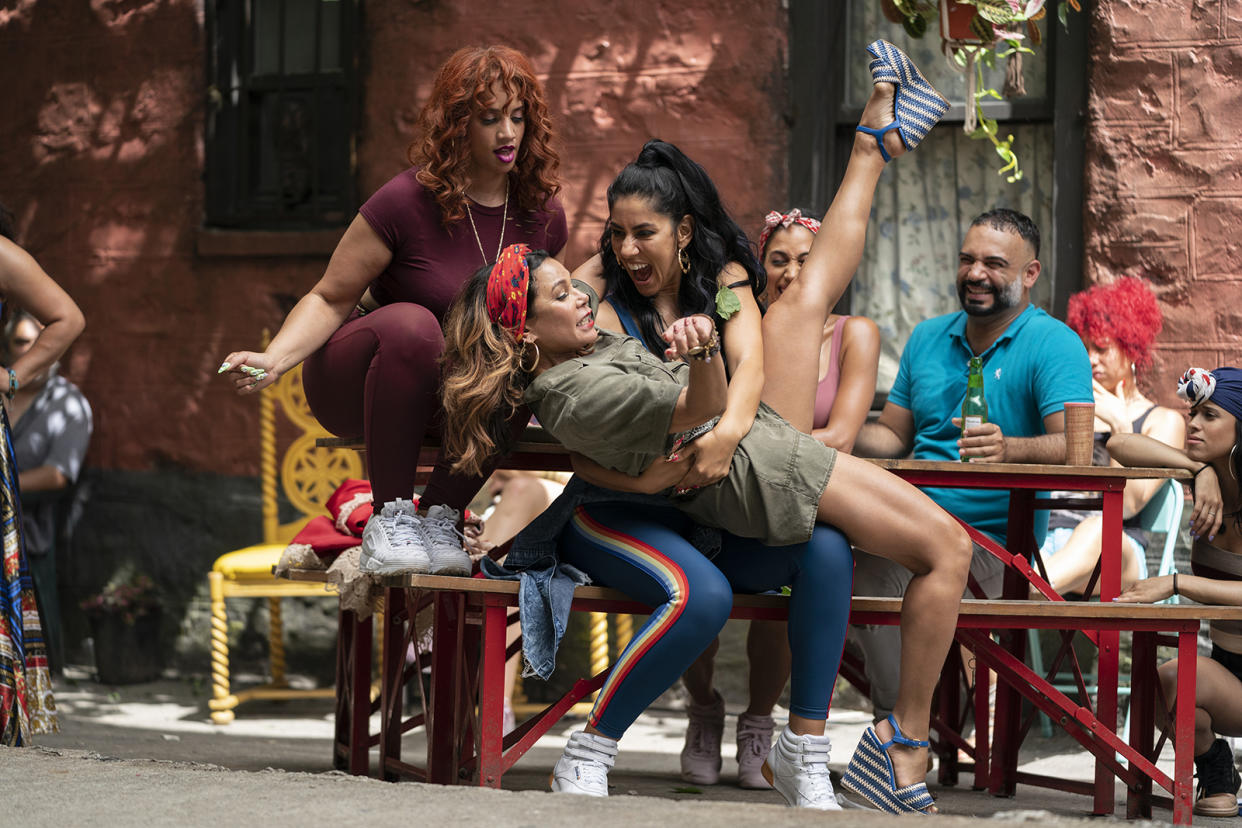‘In the Heights’ review: Sparkling screen version of Lin-Manuel Miranda’s west side story

- Oops!Something went wrong.Please try again later.
- Oops!Something went wrong.Please try again later.
“In the Heights” is a hugely enjoyable fairy tale, in which everyone’s about to be priced out of their Upper Manhattan neighborhood of Washington Heights, thanks to “rich folks and hipsters,” but they’re too busy chasing their dreams and delivering musical numbers to worry about tomorrow.
Out now in theaters and streaming on HBO Max, the movie comes with a PG-13 rating for the tiniest, least offensive smidge of “some language” and “suggestive references.” OK, well, that’s ridiculous, since “In the Heights” is a blast of positive energy, roughly 50 times more innocent and pure of heart than “Grease” and a bunch of movies your preteens have already seen.
So far, it’s also the easiest studio movie to see twice in this nervous pandemic year, especially if you have an abiding interest in why movie musicals work, or don’t.
Not everything in director Jon M. Chu’s film clicks, or needs to be there. Not every change or deletion or addition to Lin-Manuel Miranda’s 2008 Broadway original (created before ”Hamilton”) feels optimal. But it rolls, and the screen stays full to the brim at any given moment with genuine triple threats. As narrator, guide and focal point to this story, Anthony Ramos couldn’t be better in the role of Usnavi de la Vega, the Dominican American bodega proprietor originated on stage by Miranda. (Miranda returns here for a cameo as the shaved-ice “Piragua Guy.”) Crucially, Ramos complements the movie’s outsized pizzazz by taking it easy and riding it, instead of out-sparkling it.
As the opening number already online reveals, “In the Heights” has one foot in life and the other on a stack of old Playbills from musicals Miranda adores. Collaborating with librettist Quiara Alegría Hudes, who wrote the screenplay, composer/lyricist Miranda sets it all up with a title song deftly folding in the character intros. Usnavi, whose parents died young, works the corner store with his cousin Sonny (Gregory Diaz IV). His friend Benny (Corey Hawkins) works at a taxi dispatch service run by Mr. Rosario (Jimmy Smits), whose daughter Nina (Leslie Grace) is back for the summer from Stanford University harboring a secret; she’s sick of the fancy-school white privilege and not-so-veiled racism.
Everyone’s itchy for what’s next. Usnavi dreams of relocating back to the Dominican Republic to reopen his late father’s beachfront bar. Meantime he’s sweet on Vanessa (Melissa Barrera), a budding fashion designer who works in the hair salon owned by Daniela (Daphne Rubin-Vega, a killer in the original “Rent” ensemble). The salon, soon to become a casualty of neighborhood gentrification, symbolizes change; the contrasting symbol of tradition, Abuela Claudia (Olga Merediz), serves as honorary grandmother to all, and one of many who may have purchased a winning $96,000 lottery ticket.
Differences from the stage version abound, as is the case with all Broadway-to-Hollywood adaptations. The character of Nina’s mother is gone; the late-night, power-blackout looting of Usnavi’s store is gone, too. Cousin Sonny’s story becomes more central, with the added wrinkle of his hidden undocumented citizenship status. (As if this incredibly tight-knit community wouldn’t know?)
The streets-of-Washington-Heights opener recalls the rhythmic overture from “Love Me Tonight” (1932), as well as “Another Day of Sun” from “La La Land” (2016). The gravity-defying dance duet for Benny and Nina evokes Fred Astaire in “Royal Wedding” (1951), while the quick non-musical montage celebrating great Latino cultural and political heroines is straight out of Spike Lee’s playbook. There’s also a witty throwaway gag when a bit of cheesy “hold” music turns out to be “You’ll Be Back” from “Hamilton.”
I suppose I wish the material’s sociopolitical edge had more, well, edge, now that living in the Heights in the real world means (or meant, pre-COVID) $2,500 for a two-bedroom rental. In terms of form, Chu’s shot design and duration, coupled with Myron Kerstein’s editing, favors speed first, rhythmic variety second. With this cast, you want to see what they can do, for as long as possible within a single shot. “In the Heights” doesn’t work that way, but outside the elegant visual craft of Damien Chazelle’s “La La Land” very few modern film musicals work that way.
And Chu’s film succeeds on its own terms. Like the modest but wholly winning precursor to “Hamilton” it is, “In the Heights” works as an essentially apolitical embrace of the American possibility and the American roadblocks to that possibility, in a canny variety of musical styles, from hip-hop to salsa. On screen, the biggest of the big dance interludes dives back into Esther Williams MGM territory, with Chu’s staging of “96,000” in and around the Washington Heights Highbridge public pool. Christopher Scott’s the excellent choreographer. The way he gives Ramos so much to gaze upon in the opening number, through the window of his shop, crystallizes the dream along with the dreamer.
Before he hit it big with “Crazy Rich Asians,” director Chu made two “Step Up” films, “Step Up 2: The Streets” (2008) and “Step Up 3D” (2010). “Generous exuberance” were the words I used for the generally maligned latter picture. And “generous exuberance” is “In the Heights” in a bigger, brighter nutshell.
———
‘IN THE HEIGHTS’
3.5 stars (out of 4)
Rating: PG-13 (some language and suggestive references)
Running time: 2 hours, 23 minutes
Playing: Out now in theaters and streaming on HBO Max

